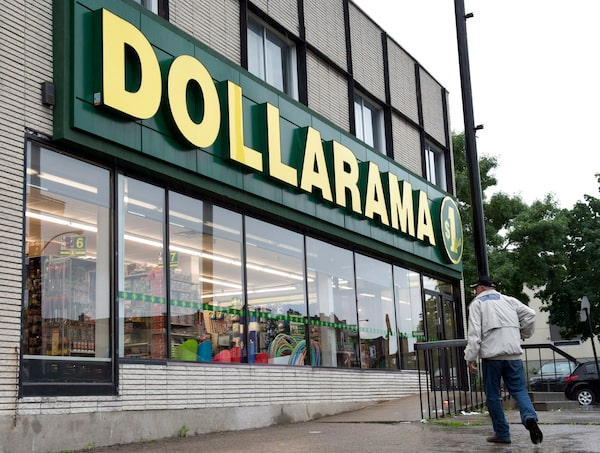
A Dollarama store on June 11, 2013 in Montreal.Paul Chiasson/The Canadian Press
Inflation is coming to the dollar store.
Discount retailer Dollarama Inc. DOL-T announced on Wednesday that price tags up to $5 will begin appearing on its store shelves in the coming year. Until now, Dollarama’s highest price point was $4.
The decision is yet one more signal that prices are rising across the board. The Montreal-based company has consistently said it would only pass on elevated costs to shoppers if competitors do so first. Retailers are facing higher costs for everything from transportation to wages, packaging and the raw materials such as plastic that go into making products.
“We’ve seen huge pressure on all retailers to increase their prices and mitigate some of the pressures that are coming from all the multiple points and inputs that create the final retail [price],” Dollarama president and chief executive officer Neil Rossy said on a conference call Wednesday to discuss the company’s fourth-quarter results.
Even with the increasing costs, Dollarama has continued to increase its profit, as sales have increased and costs related to COVID-19 have come down. The company reported its net earnings jumped to nearly $220-million, or 74 cents a share, in the fourth quarter, compared with $173.9-million, or 56 cents, in the same period last year.
At times of high inflation, shoppers typically become more price-sensitive, which can benefit discount stores. Grocery giant Loblaw Cos. Ltd., for example, recently noted that traffic to its No Frills stores has been rising. Dollarama is focused on maintaining “relative value” compared with other stores, even as its prices rise, Mr. Rossy said.
It has been more than six years since Dollarama introduced the $4 price point at its stores, and the company has been absorbing any rising costs since then, he said. Some price hikes will affect goods currently sold at the highest price point, where cost increases need to be “passed on” to consumers, Mr. Rossy added. Dollarama sells a number of goods at the $4 price point, including household items such as step stools, bowls and brooms, and electronics such as portable USB chargers, headphones and extension cords.
In addition to offsetting higher costs, adding new price points will also mean Dollarama will be able to introduce products to its stores that previously would have been out of the price range, Mr. Rossy said.
“We are doing what we’ve always done, which is ensuring the gap between us and the balance of the retail market, so that we provide our customers with the best relative value we can, while also being responsible to our investors and shareholders and employees to run a business that’s viable,” he said.
On Wednesday, the company announced a 10-per-cent increase to its quarterly dividend, to 5.5 cents a common share.
Dollarama has been opening new stores, which helped push its sales to $1.2-billion in the 13 weeks ended Jan. 30, up 11 per cent compared with the same period in the prior year. Comparable sales – an important metric that tracks sales growth not related to new store openings – also grew, by 5.7 per cent in the quarter.
The sales bump was partly because of easing restrictions related to COVID-19. In the same period the prior year, a temporary ban on the sale of non-essential items in Quebec affected roughly 30 per cent of Dollarama’s stores. While fourth-quarter sales this year were affected by the Omicron variant of the virus – which changed people’s shopping patterns and led to some provincial restrictions in December and January – Dollarama was able to sell its full product assortment and reported strong sales for its seasonal products and for household items. As restrictions have eased, the retailer has seen shoppers generally stocking up less on each trip, but visiting more frequently.
The company now has 1,421 stores across Canada, and plans to open 60 to 70 new locations in the coming year. Dollarama is forecasting comparable sales growth in the range of 4 per cent to 5 per cent. But the company also expects it will be more affected by supply chain and other inflationary pressures, including rising costs for shipping.
“The real challenge for everybody who imports a large quantity of goods, across the entire retail platform, is a logistics challenge – for the last six months to a year and will continue for the foreseeable future,” Mr. Rossy said. “… Those goods are en route, and we have enough goods that it’s a non-issue. But certainly it is more of a challenge than it’s ever been.”
The company’s warehouse space provides a buffer that has allowed it to handle supply chain delays better than many other companies, Mr. Rossy said. To support its store growth, the company is building a new 500,000-square-foot warehouse in Laval, Que., its seventh warehouse in Canada.
“There is something to be said, at times, for not-just-in-time delivery,” Mr. Rossy said.
For the full fiscal year ended Jan. 30, Dollarama reported net earnings of $663.2-million, or $2.19 a share, compared with $564.3-million, or $1.82, in the prior year. Sales for the full year grew by 7.6 per cent to $4.3-billion.
Your time is valuable. Have the Top Business Headlines newsletter conveniently delivered to your inbox in the morning or evening. Sign up today.